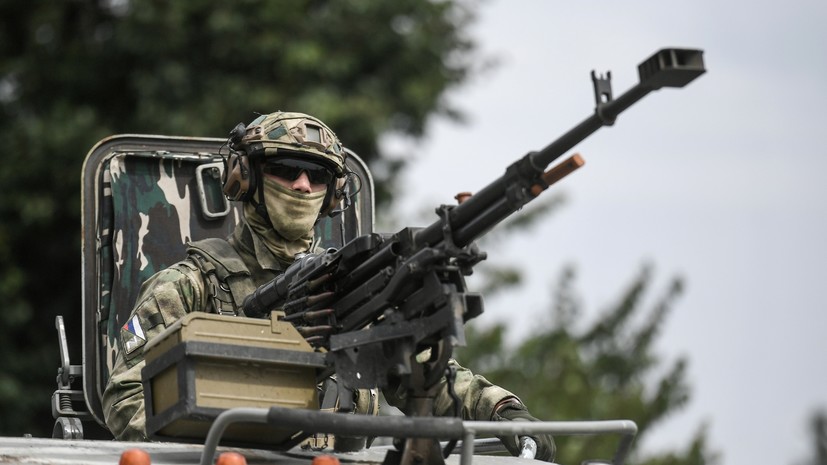The head of the Russian Defense Ministry, Sergei Shoigu, agreed with the proposal to organize defense along the line of the Dnieper River.
During the report to the minister, the corresponding initiative was made by the commander of the united group of troops in the area of the NMD, General of the Army Sergei Surovikin.
Shoigu agreed with Surovikin's arguments about the situation in the Kherson region and noted that the life and health of Russian servicemen are always a priority.
The Minister also noted that the threat to the civilian population should be taken into account.
“Make sure that all willing civilians can leave.
Proceed with the withdrawal of troops and take all measures to ensure the safe transfer of personnel, weapons and equipment across the Dnieper River," Shoigu said.
Before that, Surovikin reported in detail to the head of the RF Ministry of Defense on the situation in the Kherson direction.
In particular, the commander of the united group of forces in the NVO zone said that the Russian military successfully resisted all enemy offensive attempts.
According to the data provided by Surovikin, from August to October, the Armed Forces of Ukraine in this area lost more than 9.5 thousand servicemen killed and wounded, more than 200 tanks, as well as 500 armored combat vehicles, about 600 vehicles for various purposes and more than 50 artillery pieces and mortars .
“As you know, the attacking side suffers greater losses than the one that is on the defensive.
In this case, our losses are seven to eight times less than those of the enemy.
We think first of all about the life of every Russian serviceman,” said Surovikin.
At the same time, he drew the attention of the head of the Ministry of Defense to the fact that the enemy is striking at local governments, schools, hospitals, and other socially significant facilities.
Civilians and distribution points for humanitarian aid are also under attack.
“We successfully reflect these attacks.
About 80-90% of missiles are shot down by Russian air defense systems.
At the same time, up to 20% of them still achieve their goals,” Surovikin said.
He also stated that the engineering units of the Russian troops restore the Dnieper crossings almost daily and take measures to keep them in working condition.
As Surovikin emphasized, in such conditions Kherson and adjacent settlements cannot be fully supplied and function.
“People's lives are constantly in danger due to shelling.
The enemy is firing indiscriminately at the city, it is possible to use prohibited methods of warfare, ”said the commander of the group of troops.
He also recalled that in accordance with the decision of the administration of the Kherson region, it was decided to take the population of the right-bank part of the Dnieper to other regions.
As part of this initiative, Surovikin noted, more than 115,000 people left the district.
IDPs from Kherson who received housing certificates at a temporary stay center in Nevinnomyssk
RIA News
© Denis Abramov
In addition, the commander of Russian troops in the NVO zone drew the minister's attention to the risk of a flood zone forming below the Kakhovskaya hydroelectric power station.
“Confirmation of this is the constant missile attacks on the dam of the Kakhovskaya hydroelectric power station, as well as on the spillway gates of this dam,” he said.
According to Surovikin, if Kyiv increases the release of water from reservoirs or delivers a more powerful blow to the Kakhovka hydroelectric power station, then a stream of water will form, which will create vast flood zones.
This, in turn, will lead to significant casualties among the civilian population, the commander noted.
“There will be an additional threat to the civilian population and the complete isolation of our group of troops on the right bank of the Dnieper.
Under these conditions, the most appropriate option is to organize defense along the barrier line of the Dnieper River, ”he concluded.
Preparing mobilized Russians for participation in the NWO
The day before, Shoigu heard Surovikin's report on the current operational situation in the NVO zone.
During the meeting with the minister, the commander of the troops reported on the nature of the enemy's actions and the performance by the Russian troops of combat missions in various operational areas.
In addition, during the conversation, issues of providing all types of allowances for the military personnel who arrived in the group and were called up for military service as part of partial mobilization were discussed separately.
Shoigu again returned to the question of the participation of mobilized Russians in the special operation during a conversation with Surovikin on November 9.
He urged the commander of the troops to pay attention to the training of such servicemen.
“Before being sent to combat areas, it is necessary to place them in the rear areas, where they can conduct joint exercises with personnel with combat experience.
Only military personnel with skills in their military specialties should be sent to the front line, ”the minister noted.
He also emphasized that officers capable of "rallying military teams and organizing the performance of tasks in any situation" should be appointed to units staffed by mobilized military personnel.

